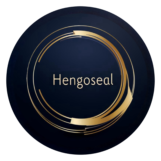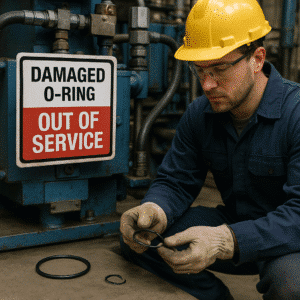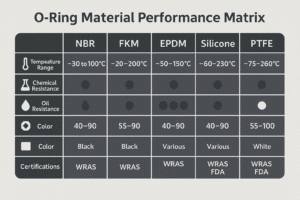Rod seal failure is one of the top reasons for hydraulic leakage. That’s why selecting the right UN seal is critical for OEM cylinder performance.
UN hydraulic seals are widely used in OEM-grade double-acting cylinders. These seals ensure smooth rod movement, prevent internal leakage, and withstand pressure up to 40MPa in mobile and industrial applications.
Not sure which UN seal suits your system? Let’s explore sizing, material, compatibility—and more.
What is a UN hydraulic seal and how does it work?
A UN seal is a single-acting rod seal commonly used in standard hydraulic cylinders.
It fits into a rectangular groove and creates a tight seal against the piston rod. Designed for medium to high-pressure systems, it’s made from abrasion-resistant materials like NBR or FKM for longer life cycles.

UN seals are ideal for cylinders where space is limited and consistent bidirectional pressure control is needed. Their lip design offers high sealing performance with minimal friction.
If you’re using OEM equipment, our UN hydraulic seals are available in standard and custom sizes.
How do you choose the correct size for UN rod seals?
Choosing the correct size is key to preventing premature failure or pressure loss.
To size a UN rod seal correctly, you need:
- Rod diameter (d)
- Groove width and depth
- Housing tolerance
- Working stroke length
UN seals typically follow ISO 5597 or AS4716 standards. Use precision calipers or refer to OEM drawings when measuring. If unsure, check our guide on how to measure hydraulic seals.
We also support custom sizing through our rubber seal customization service.
Which material is best for UN hydraulic seals?
Material choice depends on pressure, temperature, and fluid type.
| Material | Temp. max | Compatibilitate cu fluide | Caz de utilizare |
|---|---|---|---|
| BNR | 100°C | Mineral oils, air, water | General hydraulics |
| FKM | 200°C | Fuel, synthetic oils | High-temp systems |
| PU | 90°C | Abrasive media | Low-speed heavy-duty use |
If your system runs at higher temperatures or handles chemical fluids, consider FKM over NBR. Need FDA-grade? Check out Inele O din silicon for compliant alternatives.
What are the benefits of using UN seals in OEM cylinders?
UN seals are engineered for long-lasting performance in OEM hydraulic systems.
Key advantages:
- Excellent sealing with minimal leakage
- Simple installation in standardized grooves
- Broad compatibility with ISO/AS cylinder specs
- Available in multiple materials for different working media
Unlike multi-piece sealing systems, UN seals offer a compact and efficient solution for mainstream hydraulic equipment. For heavy-duty buffering, pair it with a KDAS compact seal.
When should you replace your UN rod seal?
Rod seals should be inspected regularly for:
- Leakage around the piston rod
- Hardening or cracking
- Surface scoring or shrinkage
Typically, replacement is needed every 6–12 months in high-load environments.
To avoid unscheduled downtime, use preemptive seal kits. We offer hydraulic seal kits categorized by cylinder dimensions.
Concluzie
UN hydraulic seals offer reliable, space-saving sealing for OEM and standard cylinders. Selecting the right size and material ensures long-lasting, leak-free performance.
Find the right seal for your cylinder
📩 Mail:[email protected]
📞 WhatsApp:+86 17622979498
Related topic
- Etanșare hidraulică ONU | Garnitură de tijă OEM pentru cilindri hidraulici
- KDAS Compact Seal | Buffer Seal for High-Pressure Cylinders
- Cum se măsoară garniturile hidraulice pentru o înlocuire perfectă?


